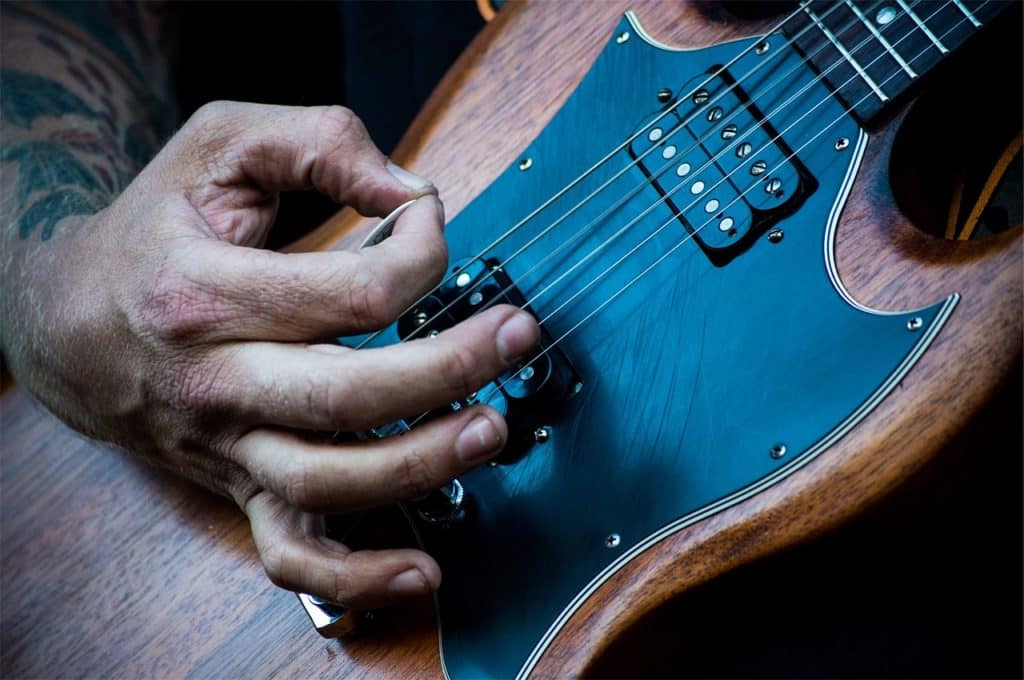E Minor Scale on Guitar
The Natural E Minor is a heptatonic scale, meaning it has seven notes per octave. The seven notes in the E minor scale are as follows:
- I-E
- II- F#
- III- G
- IV- A
- V- B
- VI -C
- VII- D
- VIII- E
Note that there is only one sharp in the group. 1# is the specific key signature used in sheet music to indicate a song is played in the key of E minor. Additionally, a 1# key signature can indicate the key of G major, but more on that later.
Looking at figure 1, all 7 of the previously mentioned notes are identified at various frets. E is highlighted in blue to indicate it as the root note. Also, from left to right starting at the 1st fret you will notice the pattern begins to repeat itself at the 13th fret. Open string to 12th fret is the range of a single octave.

Figure 1
How Do You Play an E Minor Scale on Guitar?
The E minor scale is a great scale for blues and rock. Minor chords are most often described as having a “sad” or “melancholic” sound to them compared to the chirpy brighter tones of major chords.
What is without a doubt one of the easiest chords to play and always the first chord I teach a new player is the open position E minor chord. No strings need to be skipped and requires only two strings to be fretted that are right next to each other.

Figure 2
Figure 2 illustrates the notes played when strumming an E minor chord. To build a chord you use the I, III, and V noted of its respective key. Using the notes identified above, these are the root note, E, the third note G and the fifth note B. This is further illustrated in figure 2.
To play the open position E minor shown in figure 2, use your 2nd and 3rd fingers, middle and ring respectively, to depress the strings in the second fret. Then simply strum all 6 strings. It is with this chord the basis of a song can be built and therefore the basis of a solo using the E minor scale.
Position 1

Figure 3
Using the 1st position at the 12th fret you can employ the CAGED system to memorize the shapes in which to build a base to play from up and down the neck. In figure 3 the green dots represent the root note, E, while the black dots indicate the other notes in the scale. Practicing playing through the position in figure 3 against the strumming of the E minor, G, and B minor chords.
What Notes are in the E Minor Scale?
Everything in music is built using formulas. The E minor scale is, as mentioned above, E, F#, G, A, B, C, D, E. The formula used was built off the Major Scale. For example:
E major Scale- E, F#, G#, A, B, C#, D#
The notes between the two are noticeably similar. The difference lays in the III, VI, and VII notes. All these notes are flatted, meaning they go a half step backwards. Simply put, the intervals changed.
Another easy way to remember how to build the scale is identifying the intervals. That is to say, the steps in which to move, beginning from the root note, the Whole(W)-Half(H) relationship. For the minor scale that is, W-H-W-W-H-W-W.
The similarity of E minor and E major make what is called each other’s Parallel Key . Closer still to the E minor scale is another scale. Let’s take a look at the notes and their relative position again, Starting with the root note, E.
- E
- F#
- G
- A
- B
- C
- E
The root note, where you begin your solo or melody, and its relationship with the subsequent notes is what sets the tone. The listener’s ear can recognize if the transitions are smooth or not. The relationship between the notes and the timing of when they’re played are as important as what notes are played. This is best demonstrated by E minor’s Relative Major.
Is E Minor the Same as G Major?
Each key has a relative key. If it is a minor key the relative is a major and vice-versa. A Relative Key means it has the same Key Signature, therefore, it has the same notes. The difference being the root note. Here are the notes for G Major Scale:
- G
- A
- B
- C
- D
- E
- F#
Obviously, the notes are the same but if you look closely, you can see another formula that explains how scales related. To find out what the relative major is for a minor scale you just look at the scales 3rd degree, or third note. Alternatively, if you want to find out the relative minor of a major scale simply look at the 6th degree. It’s that simple.
How Do You Solo in the Key of E Minor?

Figure 4
Figure 4 shows the tablature to play through one octave in the E minor scale beginning with the open low E string. Practice picking this up and down until you’re comfortable, playing it fluently. This allows you to train your ears to intervals between the notes as well as learning a base to start solos from.

Figure 5
Figure 5 is an advanced range of tablature, covering three octaves. This also allows you to play notes in E minor across all 5 positions. To build up the range of tones and play a broader spectrum of the notes in the key apply the CAGED method over the neck. Starting at position 1 on the twelfth fret. See figure 6 for the full 5 positions of the CAGED method.

Figure 6
Using the 5 positions of the CAGED Method allow you to place the shape on its related key, E minor. The CAGED patterns in figure 6 is based on the major scale. To apply the method simply use E minor’s relative major, G. Align the patterns from figure 6 with the notes from figure 1 and use the CAGED method patterns to memorize what notes to play while soloing in E minor.
Find a jam track in E minor to play along with. Improvisation is the key to playing solos. Use the notes you play to emphasize the chords played from the backing track.
E Minor Scale Theory and Summary
The E Minor Scale is a great tool to learn on your music journey. There are hundreds of popular, rock, and heavy metal songs in the key of E minor. The sad, melancholic tonality lends to its ability to evoke emotion that is so often cherished in music. It is closely related to similar scales such as the E minor Harmonic, The E minor Melodic, and the Aeolian Mode. All of this makes the E Minor Scale an excellent foundation from which to build your understanding of music theory.
Just some of the popular songs to play along with using the E Minor Scale are, Nothing Else Matters by Metallica, Seven Nation Army by The White Stripes, Purple Haze by Jimi Hendrix, and Creep by Stone Temple Pilots.



